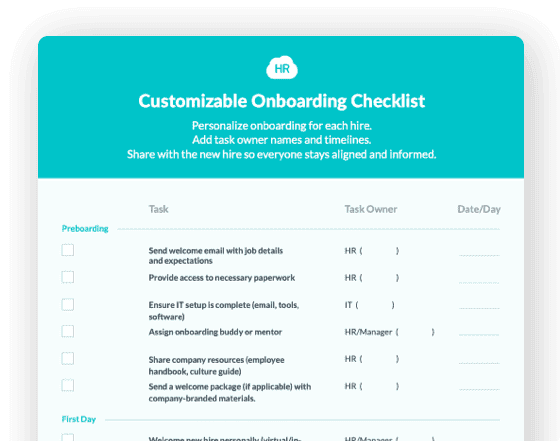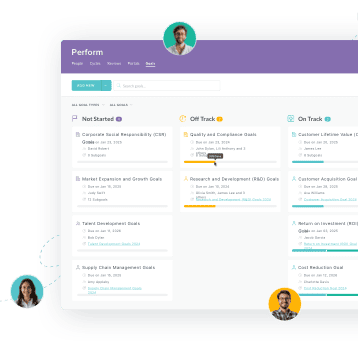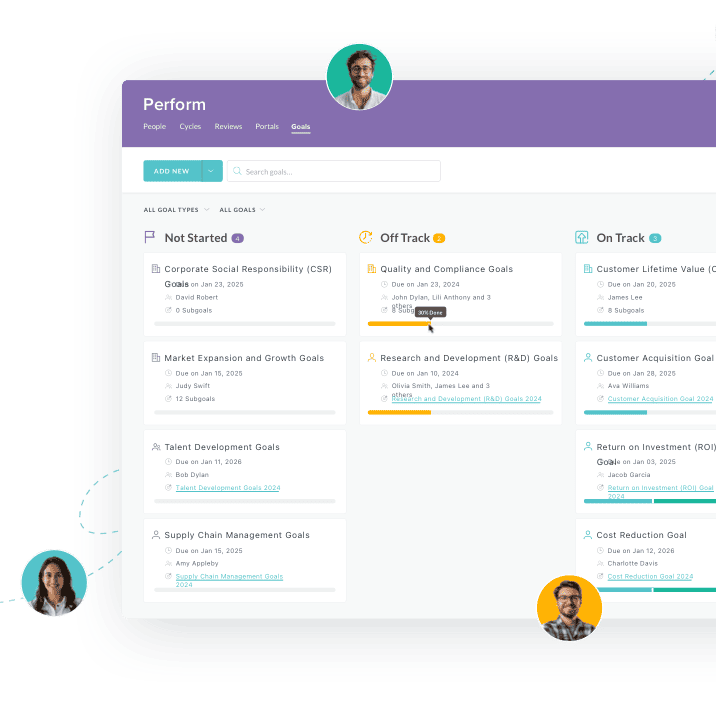Career Path Description
- Key Elements Every Career Path Description Should Include
- Comparing Traditional and Modern Career Path Approaches
- Best Practices for Writing Effective Career Path Descriptions
- Common Pitfalls to Avoid
- Career Path Descriptions Across Different Industries
- Step-by-Step Implementation Plan
- The Future of Career Path Descriptions

 Cut onboarding time
by 60%—here's the
Ultimate Checklist
that helped do it.
Cut onboarding time
by 60%—here's the
Ultimate Checklist
that helped do it.

A career path description is a written roadmap that outlines how an employee can grow and advance within an organization. It details the steps, skills, and experiences needed to move from one role to another. Think of it as a guide that shows employees where they can go and what they need to do to get there. This document typically includes job titles, responsibilities, required competencies, and the progression sequence between positions.
Career path descriptions matter because they give employees clarity about their future. When people can see a clear route forward, they stay engaged and motivated. They know what skills to develop and what milestones to reach. For organizations, these descriptions help build stronger talent pipelines and reduce turnover costs. Research from the Society for Human Resource Management shows that opportunities for career growth drive employee wellbeing more than almost any other workplace factor.
Without clear career path descriptions, employees often feel stuck or uncertain about their future. They may leave for opportunities elsewhere simply because they cannot see where they are headed. In contrast, well-crafted descriptions create transparency, build trust, and align individual ambitions with company needs.
Key Elements Every Career Path Description Should Include
Before creating or refining your career path descriptions, understand what makes them effective. Here are the essential components that should be present in every description.
Clear Role Progression:
Show the logical sequence of positions from entry level to senior roles, including both vertical promotions and lateral moves that build different skill sets.
Required Competencies:
List the specific skills, certifications, and knowledge needed at each level so employees know exactly what they should develop.
Time Expectations:
Provide realistic timeframes for advancement, helping employees set appropriate goals without creating rigid constraints.
Performance Benchmarks:
Define what success looks like at each stage through measurable outcomes and behavioral indicators.
Development Opportunities:
Identify training programs, mentorship options, and experiences that prepare employees for the next level.
Alternative Pathways:
Recognize that career growth is not always linear by showing multiple routes to advancement, including specialist tracks alongside management paths.
Comparing Traditional and Modern Career Path Approaches
The way organizations structure career paths has evolved significantly. Understanding these differences helps you design descriptions that match today's workforce expectations.
|
Traditional Career Paths |
Modern Career Paths |
|
Strictly vertical progression through management ranks |
Multiple pathways including lateral moves and specialist tracks |
|
Fixed timelines for promotions (e.g., 2 years per level) |
Flexible progression based on skills and readiness |
|
Single career ladder per department |
Career lattices allowing cross-functional movement |
|
Focus on tenure and time in role |
Emphasis on skills, capabilities, and demonstrated impact |
|
Limited visibility into advancement options |
Transparent pathways accessible through technology platforms |
|
Manager-driven career discussions once per year |
Ongoing employee-driven development conversations |
Best Practices for Writing Effective Career Path Descriptions
Creating career path descriptions that truly serve your employees and organization requires thoughtful design and clear communication. Here is how to approach this work strategically.
Start with a thorough understanding of your organization's structure and future direction. Career path descriptions should reflect where the company is heading, not just where it has been. Talk with department heads about emerging roles and changing skill requirements. This forward-looking approach ensures your descriptions remain relevant as your business evolves.
Use Simple, Accessible Language:
Avoid jargon and write in terms that employees at all levels can understand. Your descriptions should feel inviting, not intimidating or overly technical.
Focus on Skills, Not Just Titles:
While job titles provide structure, emphasize the capabilities employees need to develop. This approach gives people concrete actions they can take today to prepare for tomorrow.
Include Real Examples:
Add specific scenarios or case studies showing how employees have successfully navigated these paths. This makes abstract descriptions feel tangible and achievable.
Make Them Living Documents:
Review and update your descriptions at least annually. As your performance management processes surface new information about what drives success, incorporate those insights into your career path descriptions.
Integrate Multiple Perspectives:
Gather input from current role holders, hiring managers, and recently promoted employees. Each group offers valuable insights about what it really takes to succeed at different levels.
Connect to Development Resources:
Link each career stage to specific training programs, mentorship opportunities, or experiences available in your organization. This transforms passive information into actionable guidance.


Common Pitfalls to Avoid
Even well-intentioned career path descriptions can fall short if they contain certain flaws. Being aware of these common mistakes helps you create more effective tools.
Many organizations create career path descriptions and then file them away, never revisiting or communicating them effectively. Career paths should be active tools that managers and employees reference regularly, not forgotten documents gathering digital dust. Build them into your onboarding process, performance reviews, and development conversations. When career paths remain invisible, they cannot influence behavior or decisions.
Being too Rigid or Prescriptive:
Modern careers rarely follow neat, predictable patterns. If your descriptions suggest there is only one way forward, you will frustrate talented employees whose strengths lead them in different directions. Build in flexibility while still providing structure.
Focusing Only on Promotions:
According to Harvard Business School research, career development includes lateral moves, stretch assignments, and skill-building projects. Descriptions that equate growth solely with upward movement miss valuable development opportunities.
Ignoring Realistic Constraints:
Every organization has limits on how many senior positions exist. Setting false expectations about promotion timelines or availability damages trust. Be honest about the reality while still showing meaningful ways people can grow.
Making Descriptions too Generic:
Career paths for marketing professionals differ significantly from those for engineers or operations managers. Generic descriptions that try to cover everyone end up serving no one well. Invest the time to create role-specific guidance.
Neglecting Succession Planning Alignment:
Your career path descriptions should connect directly to your succession planning strategy. If they describe paths to roles you never actually fill internally, you undermine credibility and waste development efforts.
Career Path Descriptions Across Different Industries
The way career paths look and function varies significantly depending on your industry context. Understanding these differences helps you craft descriptions that match your specific environment.
In healthcare organizations, career path descriptions must account for stringent licensing and certification requirements. A registered nurse might see a path leading to charge nurse, nurse manager, and director of nursing. However, many healthcare professionals also value specialist tracks. Your descriptions should show parallel paths for those pursuing clinical excellence versus those interested in leadership. For example, an experienced nurse might advance to nurse educator, clinical specialist, or nurse practitioner roles that do not require managing people but still offer growth and increased responsibility. Healthcare career paths also need to reflect continuing education requirements and specialty certifications that open new opportunities.
Technology companies often embrace more fluid career structures. Engineers might move between individual contributor and management tracks multiple times throughout their careers. Your descriptions should reflect this flexibility while still providing guidance. A software developer's path might include senior developer, technical lead, engineering manager, or principal engineer options. Many tech companies also highlight rotational programs where employees spend time in different departments to broaden their skills. Your career path descriptions should make these cross-functional opportunities visible and show how diverse experiences create stronger, more versatile professionals.
In manufacturing and industrial settings, career paths often combine technical mastery with safety certifications and regulatory knowledge. A production line worker might progress to quality control specialist, shift supervisor, operations manager, and plant director. Your descriptions should emphasize how technical expertise remains valuable at every level and show clear connections between shop floor experience and management capability. Many manufacturing organizations also create specialized tracks in areas like maintenance, quality assurance, and process improvement, and these should be equally visible in your career path documentation.
Step-by-Step Implementation Plan
Creating and implementing effective career path descriptions requires a systematic approach. Here is a practical roadmap for bringing this work to life in your organization.
Step 1: Conduct a Comprehensive Role Audit.
Begin by documenting every role in your organization, including job responsibilities, required skills, and reporting relationships. This creates your baseline understanding of the current state. Interview employees and managers to understand informal pathways that might not appear on organizational charts. Often, the most valuable career insights come from understanding how people actually move through your organization rather than how you think they should move.
Step 2: Identify Logical Progression Sequences.
Look for natural connections between roles where skills build progressively. Where does an entry-level marketing coordinator typically go next? What prepares someone to become a project manager? Map these connections while recognizing that multiple paths often exist. Consider both vertical advancement and lateral moves that build breadth.
Step 3: Define Competencies and Milestones.
For each transition in your career paths, specify what knowledge, skills, and abilities someone needs to make that move successfully. Be as concrete as possible. Instead of saying "strong leadership," describe what that means in your context, such as "successfully led cross-functional team of 5 to 7 members" or "demonstrated ability to influence stakeholders without direct authority."
Step 4: Engage Subject Matter Experts.
Bring together high performers, hiring managers, and recently promoted employees to validate your draft descriptions. Ask them: What skills actually predict success in this role? What do people wish they had known before making this move? What development experiences proved most valuable? Their insights will make your descriptions more accurate and useful.
Step 5: Create Supporting Resources.
Link each career path to relevant training programs, mentorship opportunities, and development experiences. If your career path suggests someone needs project management skills, make sure you can point them to where they can build those skills. This connection between aspiration and action makes your descriptions truly valuable.
Step 6: Integrate into HR Systems.
Embed career path descriptions into your performance management platform, learning management system, and employee self-service portal. They should be easily accessible whenever employees think about their development, not buried in a handbook somewhere.
Step 7: Launch with Comprehensive Communication.
Roll out your career path descriptions through multiple channels. Hold manager training so leaders understand how to use these tools in development conversations. Conduct employee webinars explaining how to interpret and apply the information. Make it clear that these paths represent opportunities, not guarantees, while still emphasizing your commitment to employee growth.
Step 8: Establish Feedback Loops and Regular Updates.
Create mechanisms for employees and managers to suggest improvements. Review your descriptions annually and update them as your organization evolves. Use workforce analytics to track which paths employees actually follow and identify where your descriptions might need revision.
The Future of Career Path Descriptions
Career path descriptions are evolving rapidly, driven by technological advances and changing workforce expectations. Understanding these trends helps you prepare for what is coming next.
Artificial intelligence and machine learning will increasingly personalize career path recommendations. Rather than one-size-fits-all descriptions, employees will receive customized suggestions based on their unique skills, interests, and performance data. These systems will identify non-obvious career connections and suggest opportunities employees might never have considered. They will also flag skill gaps and recommend specific development activities to bridge those gaps, creating truly dynamic career guidance.
The concept of careers themselves is becoming more fluid. Research from the Harvard Business Review confirms that employees increasingly value diverse experiences over narrow specialization. Future career path descriptions will likely emphasize skills and capabilities over job titles, recognizing that someone might apply their talents in multiple contexts throughout their career. Organizations that adapt their descriptions to reflect this reality will have an advantage in attracting and retaining top talent.
Internal talent marketplaces are reshaping how employees discover and pursue opportunities. Rather than waiting for positions to open and following predetermined paths, employees can actively seek projects, gigs, and short-term assignments that build their capabilities. Your career path descriptions should evolve to incorporate these more dynamic elements, showing how different experiences combine to create valuable career trajectories. This shift moves career development from a once-a-year conversation to an ongoing process of learning and growth.
The emphasis on skills-based progression will intensify. As automation and AI transform work, the specific skills someone possesses become more important than their job title or tenure. Forward-thinking organizations are already creating career path descriptions organized around skill clusters rather than rigid job hierarchies. This approach gives employees more flexibility in how they grow while helping organizations maintain the capabilities they need. By clearly articulating which skills drive advancement, you empower employees to take control of their development in ways that benefit both them and your business.
 Discover how our HR solutions streamline onboarding, boost employee engagement, and simplify HR management
Discover how our HR solutions streamline onboarding, boost employee engagement, and simplify HR management
Keep Reading
From Manual to Automated: A Complete Guide to Digitizing Employee Onboarding for Large Organizations
Sarah Chen, Director of HR at a 7,000-employee healthcare organization, starts her Monday
Enterprise HR Software in 2025: Why Traditional Enterprise Platforms Fall Short and What Actually Works
Traditional enterprise human resources software systems promise comprehensive solutions
AI in Onboarding: Complete Guide for 2026
You’ve probably been hearing this multiple times a day — AI is transforming HR. But
Ready to streamline your onboarding process?
Book a demo today and see how HR Cloud can help you create an exceptional experience for your new employees.

